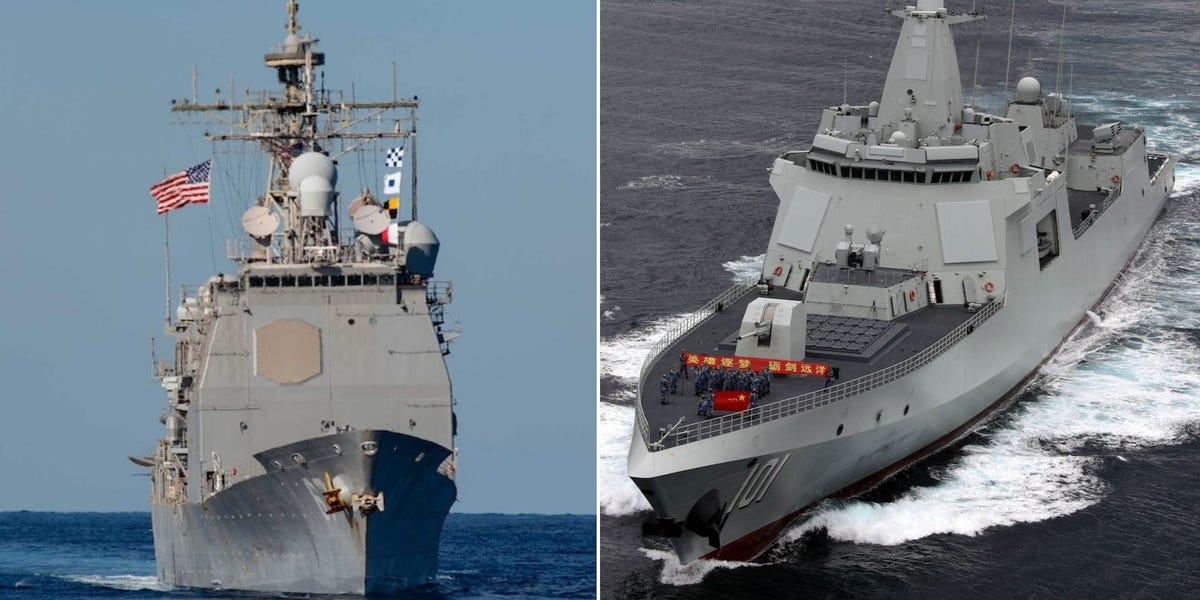How Ticonderoga-Class, Type 055 Destroyer Compare

China’s naval capabilities have taken a significant leap forward with the introduction of the Type 055 class-guided missile destroyer. This new addition to the People’s Liberation Army Navy (PLAN) is not just a destroyer; it is a formidable surface combatant that rivals the United States Navy’s cruisers. As the U.S. moves to retire its aging fleet, China is rapidly expanding its naval forces, raising concerns about the balance of power in the Pacific.
The Type 055 ‘Renhai’: A New Era of Naval Warfare
The Type 055, also known as the Renhai-class, represents a culmination of decades of Chinese naval aspirations. The desire for a powerful surface combatant dates back to the 1960s, but it wasn’t until the mid-2010s that China began to realize this ambition. The first ship of the class, Nanchang, was commissioned in 2020, marking a new chapter in naval warfare. Measuring 590 feet in length and displacing between 12,000 and 13,000 tons, the Type 055 is the largest surface combatant ever built by China.
Equipped with 112 vertical launch system (VLS) cells, the Type 055 can launch a diverse array of missiles, including anti-ship, land-attack, and surface-to-air missiles. This versatility allows it to perform multiple roles, from anti-submarine warfare to acting as a command flagship for naval operations. The ship’s advanced radar and sensor systems, including the Type 346B Dragon Eye radar, enhance its situational awareness and targeting capabilities.
China’s rapid construction of the Type 055 class is noteworthy. Currently, eight ships are in service, with plans to build as many as 16. This expansion comes at a time when the U.S. Navy is grappling with the retirement of its older Ticonderoga-class cruisers, which have been in service since the 1980s. The Type 055’s advanced technology and firepower position it as a leading contender in the global naval arena, prompting analysts to classify it as one of the best surface combatants in the world.
The Ticonderoga-Class: Aging but Still Relevant
In contrast to the Type 055, the U.S. Navy’s Ticonderoga-class cruisers are facing an uncertain future. These ships, which measure 567 feet and displace around 10,000 tons, have been pivotal in U.S. naval operations since their introduction in the early 1980s. Each Ticonderoga-class cruiser is equipped with a robust missile arsenal, including Tomahawk cruise missiles and various anti-aircraft systems, making them versatile assets in carrier strike groups.
Despite their capabilities, the Ticonderoga-class cruisers are aging. The U.S. Navy has expressed concerns about the maintenance costs and operational readiness of these vessels. Many of the cruisers are approaching the end of their service lives, and the Navy has proposed retiring several of them to allocate resources for newer ships. However, Congress has resisted these plans, fearing that the loss of these cruisers could weaken the U.S. response to China’s growing naval power.
The Ticonderoga-class cruisers play a crucial role in air defense and multi-mission operations. Their advanced AEGIS Combat System integrates radar and missile systems to provide a comprehensive defense against various threats. However, with only nine of the original 27 cruisers still in active service, the U.S. Navy faces a potential “cruiser gap” as it seeks to modernize its fleet while maintaining a credible deterrent against adversaries like China.
The Future of Naval Power: A Growing Divide
The contrasting trajectories of the Type 055 and Ticonderoga-class cruisers highlight a significant shift in naval power dynamics. As China continues to build and modernize its fleet at an unprecedented pace, the U.S. Navy grapples with the challenges of maintaining its aging vessels. The Type 055’s advanced capabilities and rapid production raise questions about the future of naval warfare and the balance of power in the Pacific.
China’s aggressive expansion of its naval forces, including the Type 055, signals its intent to assert dominance in regional waters. The U.S. Navy’s struggle to maintain its cruiser fleet underscores the need for a strategic reassessment of its naval capabilities. As both nations navigate this evolving landscape, the implications for global security and maritime stability are profound.
The emergence of the Type 055 cruiser represents a pivotal moment in naval history. With its advanced technology and formidable arsenal, it challenges the traditional dominance of U.S. naval power. As the U.S. seeks to modernize its fleet, the growing capabilities of the PLAN will continue to shape the future of naval warfare.
